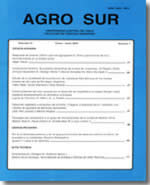Penetration resistance of an humic vitrixerand and a vitrandic haploxeroll with different uses
Main Article Content
Abstract
The effects of land use and machinery transit on penetration resistance, bulk density and total porosity were studied in an Humic Vitrixerand and a Vitrandic Haploxeroll located in the forest-steppe transition area of SW Neuquén,. The land uses studied were the first planting of Pinus ponderosa Dougl., close to a cutting area and extensive grazing of sheep and goats to give an estimation of the present condition of the soil. To examine the possible changes due to machinery transit, a tractor was passed over the site up to eleven times at four fixed depths. Total porosity was closed to 60 % and dominated by macropores. Bulk densities were from low to medium (1,1 Mg m-3) and no change was observed under forest use. A lower resistance to penetration (RP) was found on Andisol in all cases. A trend towards a lower penetration resistance under pine planting was found in both soils, with the difference being highly significant for the Mollisol. Successive tractor transit did not result in an increased penetration resistance. forestations tended to generate better soil conditions for root growth (RP < 2 MPa). Both soils showed a particular behavior and no signs of compaction were observed.

